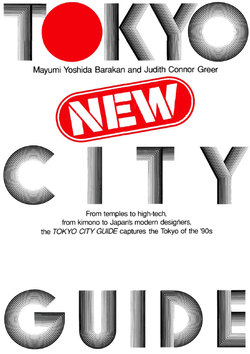Читать книгу Tokyo New City Guide - Mayumi Yoshida Barakan - Страница 7
На сайте Литреса книга снята с продажи.
ОглавлениеHOW TO USE THIS BOOK
Cross-referencing
The book is divided into three main sections. The beginning covers the history of the city, its districts, and neighborhoods. The middle section is divided into guide chapters covering specific topics: accommodation, restaurants, shopping, arts, etc. The book ends with the map sections. There are fifty maps charting most of the listings found in the guide sections and covering the districts described in the first chapter. Next to each map is a list of its contents with the text-page reference number for each entry.
Our intention was to provide a complete cross-referencing system. Ideally, you should browse through the entire book. But if you're in a hurry and are looking for something specific, e.g., a sushi restaurant, then you can look one up in the restaurant chapter under sushi. If you want to spend a day in a particular district, read about the history and description of the district in the first chapter, then turn to the map to see what the area has to offer in terms of shops, restaurants, etc.
How We Selected
Even with a book this size, only a fraction of what the city has to offer can be included. But then, we didn't intend to compile a phone directory. We have selected and included things we know, things we like, and things we would like others to know about. Our selection covers a broad range of prices, and a huge range of possibilities. Convenience figured to some extent. Some places we couldn't include because their Japanese owners didn't want to be made public.
While the decisions were basically our own, we consulted various local "experts" to discover new places, and to reconfirm that our decisions were not made purely on the basis of sentimental association. Our "experts" included born and bred Tokyoites aged sixty-plus, foreign residents of all ages and nationalities, journalists, artists, shop owners, etc. Many of the older shops and restaurants are famous Japanese institutions; the newer places are often those less known among both Japanese and the international community.
How You Can Select
There is a great deal of information in this book. For a future resident or long-term visitor this may be useful, but for a short-term tourist possibly confusing. For short-term visitors, our suggestion is to pick one new and one historical district to explore—for example the Aoyama-Harajuku area or Shinjuku for contemporary Tokyo and Asakusa for old Tokyo. Spend the evening in Roppongi. From our listings for restaurants (or accommodation), you can choose according to price range. All offer excellent quality, if not quantity, for the price.
Listings
The shops, restaurants, hotels, etc., listed in this book, with few exceptions, correspond to a number on one of the maps in the map section. The map reference number is marked after each entry as, for example, [M-3], meaning "Map Number Three." The exceptions are not located on any of our maps and are marked [off Map]. Sometimes we have included instructions for how to get to these "mapless" entries, other times we have just listed the nearest station.
The prices and addresses are valid as of publication, but Tokyo changes very quickly. Some of our favorite places closed down while we were writing the book, and more will doubtless close within the next year. In most cases it won't be necessary, but if you are planning to go out of your way to visit a particular shop or restaurant, we suggest that you call ahead just to make certain that it is still in business and in the same location.
Most addresses have been written in English, but for some of the more difficult-to-locate entries we have included the names and addresses written in Japanese so you can show the book to someone if and when you get lost.
When an entry appears more than once in the text, the address, hours, etc., have been noted with the main entry.
Proper Names
Japanese proper names have been written in the Japanese manner with the family name first.
Place Names
Place names have been written in the Japanese form. For example Yoyogi Koen means Yoyogi Park, but if you ask a Japanese person where Yoyogi Park is, few people will understand you. The same goes for museums, gardens, temples, etc. Sometimes we have listed an entry as, for examples, "Senso-ji temple." The "ji " means temple, so the entry literally translates as Senso Temple temple. There is no practical way around this.
Italics
In all but a few isolated cases, all words in italics—that are not personal or place names—are Japanese terms.
Pronunciation
We recommend that you consult the pronunciation guide in the language section before attempting to use any Japanese language. In most places throughout the book, where Japanese words appear in the text long vowels have been indicated.
Romanizations of Japanese words in the text are slightly different from those normally used for teaching Japanese, but we have attempted to make them as easy to read as possible for those not acquainted with the Japanese language.
Language Section
The chapter on the Japanese language was written by Peter Barakan, a resident of Tokyo since 1974 who speaks flawless Japanese and holds a university degree in the language. He is British, which is important for non-British speakers of the English language to remember when following the instructions for pronunciation.
In addition to endless researching and telephoning, we have walked the streets of Tokyo trying to make this book as error free as possible. But in spite of our efforts, there will be mistakes: hours and prices change; shops open and close; the maps may have omissions. You may hate our selections. For this we would like to apologize.
